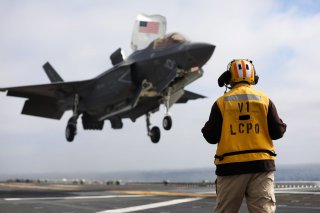Deployed to Okinawa, Japanese F-35 Fighters Take Up an Anti-China Mission
The U.S. Marine Corps’ F-35B—its version of a fighter being fielded by the Air Force and Navy—has vertical landing capabilities, but those may have compromised some aspects of the Lightning II’s performance.
Here's What You Need To Know: If Chinese ships and aircraft can isolate the Senkakus, then it will be easy for Chinese troops to occupy them. And very difficult to Japan to recapture them: the special amphibious brigade created by Japan would be a sitting duck. But even a few F-35Bs operating from rough airstrips—and perhaps armed with hypersonic anti-ship missiles—could disrupt a Chinese amphibious landing.
Japan may deploy its new F-35 stealth jet fighters to an airbase in southwestern Japan.
The location is not coincidental: Nyutabaru Air Base, in Miyazaki Prefecture, is situated nearer to Japanese islands and waters claimed by China.
“The envisioned deployment of the aircraft to Nyutabaru Air Base is aimed at keeping in check China’s maritime assertiveness around the area, including the Japanese-controlled Senkaku Islands in the East China Sea,” according to an article in the Japan Times. China claims the islands, which are located near China and Taiwan, as its own, and has repeatedly sent ships and aircraft into the area.
“With Beijing’s increasing maritime activities in mind, Japan is stepping up its capabilities to protect the Nansei Islands covering Okinawa and the Senkakus,” the newspaper said.
Government sources told Japan Times that “the F-35Bs are expected, after being deployed to the Nyutabaru base, to conduct joint exercises with other F-35Bs already deployed at the U.S. Marine Corps’ Air Station Iwakuni in Yamaguchi Prefecture. It is also envisaged that eventually upgraded Izumo-class flat-top helicopter carriers will transport and launch fighter jets such as F-35Bs, the U.S. Marines variant of the F-35 stealth plane made by Lockheed Martin Corp.”
However, local opposition could derail the planned deployment, the newspaper noted.
Japan is buying two versions of the F-35: 105 F-35A land-based fighters for the Japanese air force. The first batch are already deployed at Misawa Air Base in Aomori Prefecture in northern Japan, watching Japan’s other main security threat, North Korea.
Japan also plans to acquire forty-three F-35B short takeoff and vertical landing (STOVL) jets by 2023, with the first models arriving by 2023. Some would be stationed at Nyutabaru.
How Japan is deploying the two different F-35 models reveals the multiple—and vastly different—security challenges confronting the Japanese military. The more powerful F-35As are stationed in northern Japan, facing North Korea. While North Korea’s conventional military is no particular threat to Japan, North Korea’s ballistic missiles—which could carry nuclear warheads—do worry Tokyo. The F-35s—which the United States has already tested in a missile defense role—could be used to shoot down ballistic missiles or use its stealth capabilities to destroy North Korean missile and nuclear weapons sites.
China presents a different threat. Though Beijing has ballistic missiles aplenty, China has a large air force and navy that is rapidly growing in sophistication, including aircraft carriers and hypersonic missiles that could damage U.S. and Japanese airbases. During a wargame conducted by the Washington-based Center For a New American Security thinktank last year, the Chinese team used ballistic missiles to devastate Okinawan airfields packed with U.S. and Japanese aircraft.
If airfields on Okinawa are vulnerable, then how about the Senkakus, small, barren and uninhabited pieces of rock that lack infrastructure, are uncomfortably close to mainland China, and would be extremely difficult to defend?
All of which suggests that conventional fixed-aircraft—the F-35As and F-15s that are the backbone of U.S. and Japanese air arms—may find themselves trying to operate from bombed-out airbases and cratered runways on Okinawa and other Japanese islands. Which is exactly the kind of predicament that the F-35B is designed for.
The U.S. Marine Corps’ F-35B—its version of a fighter being fielded by the Air Force and Navy—has vertical landing capabilities, but those may have compromised some aspects of the Lightning II’s performance. On the other hand, such landing capabilities does allow the F-35B to operate from rough airfields. For the U.S. Marines, who prefer their own in-house air support rather than relying on the Air Force and Navy, the F-35B could operate from crude airstrips on a newly-seized amphibious beachhead.
Whether this is actually true is a different matter: just because the F-35B can land on any bare patch of ground, that doesn’t mean that fuel, ammunition, spare parts and trained mechanics will be there. Nonetheless, if Japanese planners have to reckon on the possibility that permanent airfields could easily be devastated by Chinese missiles, then Tokyo has a problem.
As Japan discovered in World War II, the only real defense against amphibious invasion is for air and naval defenses—and mostly airpower—to stop the invasion. If Chinese ships and aircraft can isolate the Senkakus, then it will be easy for Chinese troops to occupy them. And very difficult to Japan to recapture them: the special amphibious brigade created by Japan would be a sitting duck. But even a few F-35Bs operating from rough airstrips—and perhaps armed with hypersonic anti-ship missiles—could disrupt a Chinese amphibious landing.
Michael Peck is a contributing writer for the National Interest. He can be found on Twitter and Facebook.
This piece first appeared earlier this year and is being reprinted due to reader interest.
Image: Flickr.

